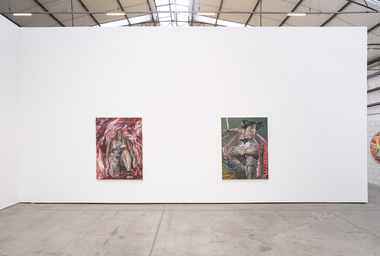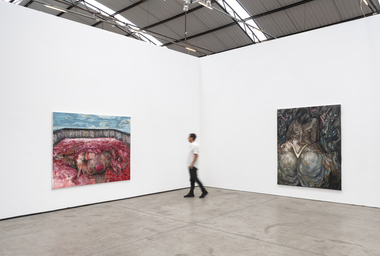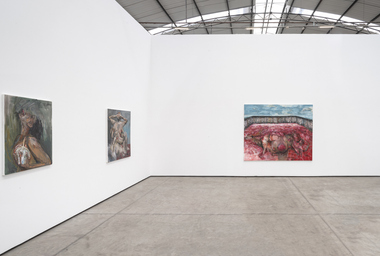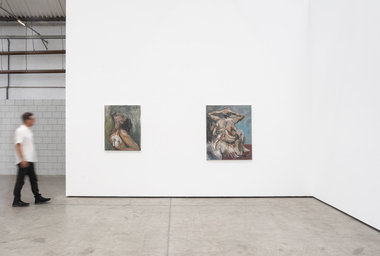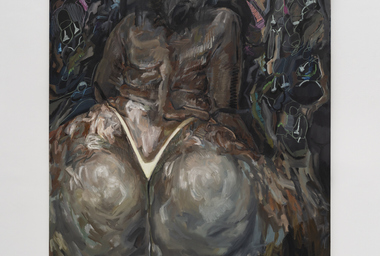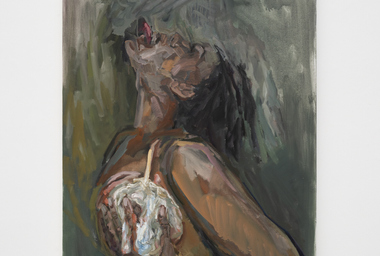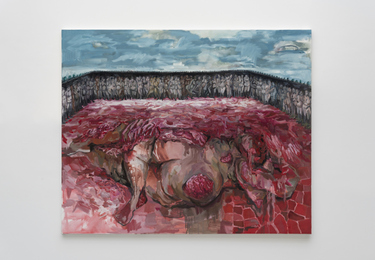
Red Tile Fragments
By Raphael Fonseca
In Márcia Falcão’s research, the ‘Brazilian woman’ – repeatedly overly sexualized, objectified and stereotyped by hundreds of authors in the visual arts and in mass culture – is not dancing samba, covered in glitter, to the sound of ‘Here I come, here I come / Today I’m partying on the avenue’. Falcão’s work reminds us of a constant tension between pleasure and violence, between the celebration and the violence that afflict so many women around her. Far from pointing the finger, these are images that embody the contradiction of being alive in Rio de Janeiro, in Brazil or anywhere else in the world.
We can begin reflecting on the works brought together in this exhibition by looking at their titles: Badass, Catedral [Cathedral], Adorando pelo avesso [Reverse Adoring], Matriforma [Mater-form] and O êxtase [The Ectasis], amongst others. In these formulations, there is an evident association between the female body and the church, between image and the ass, between painting and maternity. If cathedrals were once – and still are for some people – welcoming spaces, Falcão is more interested in how the female body and perhaps how her own body, when transformed in painting, can simultaneously be a place of shelter and abjection.
Let us look now at Catedral (2022). At the center of the composition, a woman is represented from the back. Out of her spine we see the emergence of architectural structures in the shape of an ogival arch, like those of gothic buildings. This reference to European architecture, however, is treated in a way that takes this form of culture to the working-class suburbs of Rio de Janeiro: the constructions are decorated with pieces of red tile, similar to those seen on the paved floors of Irajá, the neighborhood the artist grew up in. The female body is presented as the foundation of painting and of the metaphor introduced by the notion of a cathedral. The sacred voluptuous female space proposed by Falcão is obscured and contaminated by the notion of domesticity that seems to asphyxiate the painted body.
In Matriforma (2022), this analysis is even clearer. Once again with her back turned to us and flaunting a large and curvaceous silhouette, an amorphous human figure is presented to the spectator. In the details of her entrails, between brown and red, we notice forms in the shape of babies attached to her upper body. All the elements are fused into a single mass; the body’s individuality – which we can easily relate to the notion of matriarchy – seems diminutive against the lack of a face. The body appears to disintegrate amongst the brushstrokes, as if it was nothing but the agent of breastfeeding and care for the central figure’s supposed children. In this painting, is there any room for pleasure or is it all about drudgery?
In Adorando pelo avesso (2022) – the only work in the exhibition where the face of the female figure is turned to the viewer – we notice the way Falcão transitions between the red of popular architecture and the many tones of what looks like a butcher’s shop. Partially kneeling down and naked, the large woman, like a caryatid, is looking at us with ajar lips – a moment to breathe through her mouth? A pause before a speech? Like in every painting, mystery is offered to our eyes and imagination. In any case, we are certain that there is no empty space or calmness for this figure; her black skin is completely surrounded by reds that engulf the background, the bottom of the painting and the centralized body. She is the survivor of the carnage of life in its everyday banality.
Step by step, Márcia Falcão suggests an inventory of uncomfortable situations that surround these characters – or perhaps that surround the artist herself. Far from giving us all the answers at once, she seems interested in offering us one of the things she loves most in life – painting and her ability to create narratives with no closed meanings. Whether in her allegories of urban violence or in her dilacerating views of the many forms of solitude endured by non-white women, in particular those who are mothers like her, Márcia Falcão invites us to join together the pieces of her puzzles. For the artist, painting is a way of providing meaning to shattered existences. Just like life itself, there will always be something missing, but in the meantime we can collect the fragments of her red floors and learn about the stories that her paintings tell us.
